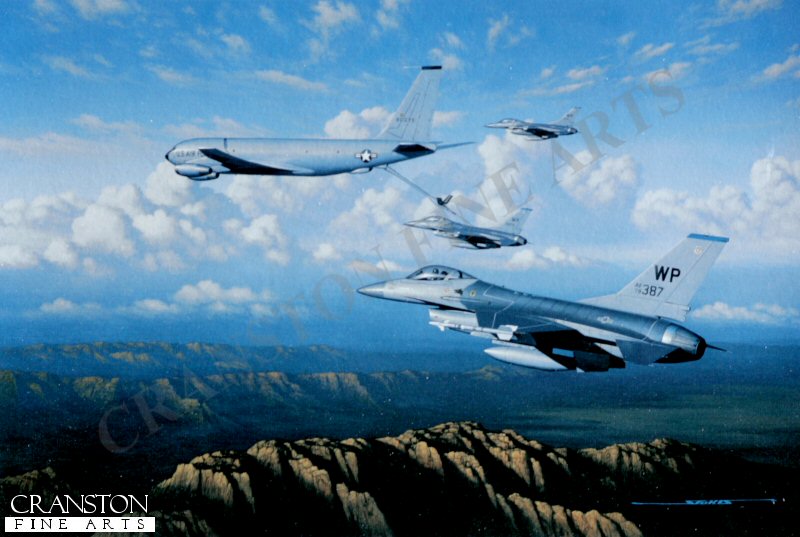- Sku:
- Vendor: Military Aviation Art Prints
Thirsty Falcons by Stan Stokes. (B)
Aerial refueling revolutionized aerial warfare. The first such documented refueling took place in June of 1923 when a specially modified DH-4B piloted by Lts. Virgil Hine and Frank Seifert took off from Rockwell Field in San Diego and managed to refuel another DH-4 piloted by Capt. Lowell Smith. The success of this aerial refueling permitted an attempt at a world record of flight duration. Taking off again from Rockwell Field Smith kept his aircraft airborne for more than 33 hours. Aerial refueling remained a novelty until many decades later when the jet age arrived. Modern jet-powered fighters are awesome machines, but they can consume enormous amounts of fuel, especially when flying at maximum speeds or climbing under maximum power. A jet taking off with a full weapons load that climbs to 60,000 feet under full power may consume more than half its fuel capacity. Aerial refueling was necessary to make jet powered fighters and bombers a practical weapon. In the 1950s the Air Force developed a flying boom method of refueling whereas the Navy utilized a probe and drogue system. The former required a specially trained boom operator but can pass fuel very quickly. The Navy system could handle multiple aircraft at the same time, but required a higher standard of flying. Both in Vietnam and later during the Gulf War, aerial refueling proved invaluable to the success of the air campaigns. In Stan Stokes painting, F-16 Falcons approach their tanker for refueling. The F-16 Fighting Falcon, designed by Harry Hillaker, first rolled out of the General Dynamics assembly line in Ft. Worth Texas in October of 1976. The aircraft was originally built as a technology demonstration exercise to show how much weight and cost could be eliminated from the F-15 Strike Eagle. In 1975, at the Paris Air Show, the F-16 prototype with test pilot Neal Anderson at the controls competed in the Great Fighter Competition. To the winner; billions of potential sales to countries like Belgium, Denmark, the Netherlands, and Norway. The F-16 duked it out against the French-built Mirage F1-E and the Swedish Saab 37 Viggen. The F-16 was the winner. Interest in a new lightweight, cost-effective, fighter-interceptor evolved in the mid-1970s as a replacement for the aging F-104. The F-16s outward appearance has remained the same for twenty-five years while remarkable advances in technology have been incorporated into the aircrafts internals. Improved engines, enhanced radar and avionics, and superior missiles have kept the F-16 effective. The F-16 can carry nearly ten tons of armament on its external stores stations. This range of armament includes air-to-air missiles, air-to-ground missiles, intelligent and traditional bombs, 6000 round per minute Vulcan guns, and external fuel tanks.
Limited edition of 100 giclee art prints.
Size 21 inches x 14 inches (53cm x 36cm)
Have a question?

Thirsty Falcons by Stan Stokes. (B)


